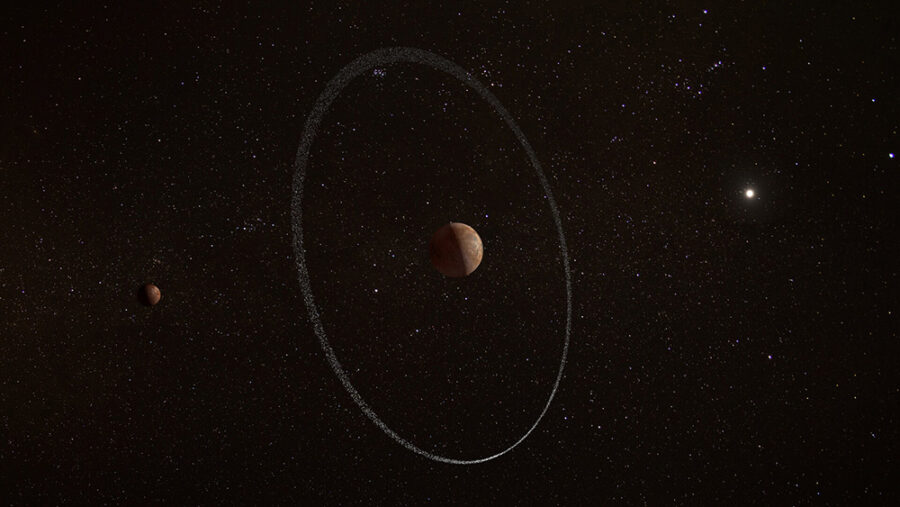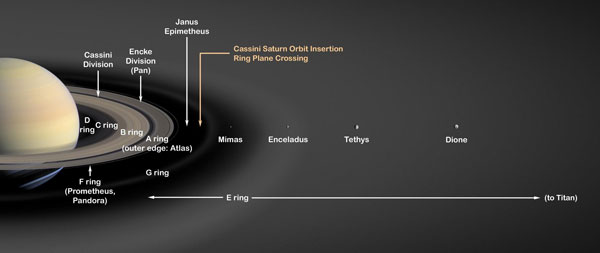There’s a strangely large-diameter ring around the outer solar system world Quaoar.

ESA, CC BY-SA 3.0 IGO
The distant dwarf planet 50000 Quaoar appears to have a ring that spans far beyond where it ought to be stable. “That is not where it was supposed to be,” says Bruno Morgado (Federal University of Rio de Janeiro, Brazil), lead author of a team of 59 astronomers who report the discovery in Nature.
French astronomer Edouard Roche defined the concept of the Roche limit in 1848, calculating where a planet's tidal forces would exceed the gravitational force holding a moon together. Inside that region, the stronger gravitational force of the planet overpowers the moon’s gravity and that tidal pull eventually tears the moon apart. Only outside that limit can small objects, dust, and debris coalesce under their own gravity to form a moon. With the ring’s discovery, the Roche limit may need a rethink.
Although the limit is somewhat of an approximation, it has served as a good rule of thumb in the solar system. Saturn’s main rings, as well as those around the other giant planets, lie inside the planets’ Roche limits. The same is true of the dwarf planet 136108 Haumea. The smallest object known to have rings is 10199 Chariklo, and these also lie within its Roche limit. But the uneven ring around Quaoar breaks the rule, lying beyond the dwarf planet’s Roche limit.

NASA / JPL
At 1,110 km (690 miles) in diameter Quaoar is one of the largest objects known in the outer solar system. Its single moon, named Weywot, spans about 160 km and was discovered in Hubble images in 2007. But the first signs of material around Quaoar didn’t come until 2018; even then, evidence was insufficient to call it a ring, says Morgado. He began studying Quaoar in 2020 with the European Space Agency's CHEOPS space telescope, originally designed to find and characterize exoplanets. Rather than looking for exoplanet transits, Morgado used CHEOPS to observe stellar occultations, when Quaoar passed in front of distant stars and momentarily blocked their light.
Now Morgado has extended that work, working with others to observe Quaoar’s stellar occultations using other telescopes. The team first predicted a few occultations and recorded them. Then, after those observations hinted at a ring, the researchers went back through previous occultation records. “We saw the ring in nine different regions, from observations taken between 2018 and 2021,” Morgado explains.
In Nature, the team reports the presence of a ring 4,100 kilometers from the center of Quaoar, far beyond its classical Roche limit of 1,780 km. Morgado says the ring is dense and irregular. “It has a very thin region about 5 km wide and also a large region about 300 km wide, depending on which part of the ring was probed,” he notes. If the material could all be collected into a single moon, it would be about 10 km in diameter, less than a tenth of Weywot’s size.
A few thin, light rings exist beyond the Roche limit elsewhere in the solar system — like the tenuous rings beyond Saturn's F ring — but nothing so massive as the ring around Quaoar. “We were very surprised by the existence of such a ring,” says Morgado. A ring at this distance shouldn’t be stable; it ought to either collapse together or drift apart over time.
Though it might have formed after a recent collision in the Quaoar system, that seems unlikely because such a ring should only last a few decades. Other hypotheses Morgado and colleagues pondered include orbital resonances with Quaoar and its moon Weywot, or unusual interactions involving ring particles. In the end, they conclude it might be time to rethink the classical Roche limit.
"The finding of possible ring material around another small body in the solar system is intriguing," says Amanda Sickafoose (Planetary Science Institute), though she notes that the team didn’t demonstrate a full ring system. The scale and dynamics of such smaller bodies, “are considerably different . . . to those of the giant planets,” she adds, “calling into question our basic understanding of how ring systems form and evolve.”
 6
6









Comments
Cousin Ricky
February 8, 2023 at 8:02 pm
The link to the article about 10199 Chariklo is broken.
You must be logged in to post a comment.
Monica Young
February 9, 2023 at 10:39 am
Thanks for the note, I've fixed the link.
You must be logged in to post a comment.
PGT
February 9, 2023 at 4:59 pm
Should it be 500000 Quaoar, or 50000 Quaoar?
You must be logged in to post a comment.
Monica Young
February 10, 2023 at 10:51 am
Also fixed - one too many zeroes!
You must be logged in to post a comment.
Renato Langersek
February 9, 2023 at 10:49 pm
Just to set facts straight, Quaoar's Ring was discovered by Australian Amateur Astronomers Jonathan Bradshaw, Renato Langersek and John Broughton on August 27th 2021 and confirmed by previously collected data as per Dr. Bruno Morgado's paper in the Nature publication.
Best regards,
Renato Langersek
You must be logged in to post a comment.
Monica Young
February 10, 2023 at 10:52 am
Thank you for naming the amateur astronomers involved in the discovery!
You must be logged in to post a comment.
You must be logged in to post a comment.